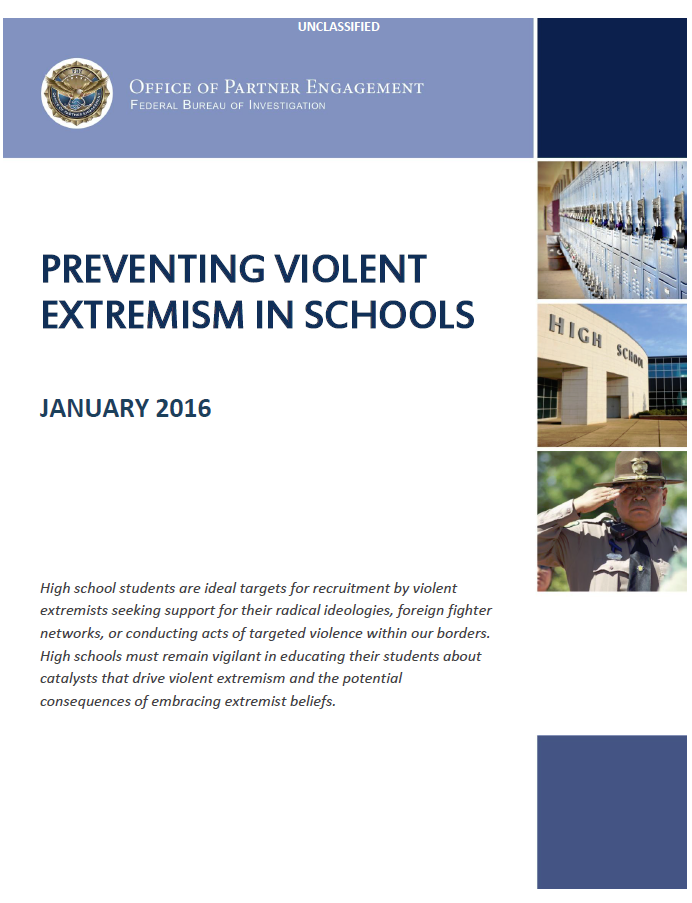Despite efforts to counter violent extremism, the threat continues to evolve within our borders. Extremism and acts of targeted violence continue to impact our local communities and online violent propaganda has permeated social media. Countering these prevailing dynamics requires a fresh approach that focuses on education and enhancing public safety—protecting our citizens from becoming radicalized by identifying the catalysts driving extremism.
Emerging Trends
Youth are embracing many forms of violent extremism; those perpetrated by terrorist organizations or other domestic violent extremist movements, to those maintaining biases towards others due to their race, religion, or sexual orientation. Youth aged 13 – 18 are actively engaged in extremist activities including online communication with known extremists, traveling to conflict zones, conducting recruitment activities, or supporting plotting against U.S. targets. These factors signify the potential for increased risk within our schools and local communities.
Although violent extremists are predominantly male, there are noted increases in the number of females embracing violent radical ideologies due in part to their roles becoming more defined. Extremist organizations actively seek females to fill operational roles, including carrying out attacks in the Homeland or traveling to fight—in addition to historic supportive activities such as fundraising or traveling to marry foreign fighters.
Impact on Schools
As this threat evolves and more youth embrace extremist ideologies, it places a growing burden on our educational system to provide appropriate services to students who view hatred or targeted violence as acceptable outlets for their grievances. To complicate matters, youth possess inherent risk factors making them susceptible to violent extremist ideologies or possible recruitment. A current body of research on developmental behaviors, which is discussed later in this guide, suggests that a youth’s risk factors and stressors, if not properly addressed through personal actions or third-party intervention, can lead to negative outcomes in the form of suicide or violence against others.
Our educators are in a unique position to affect change, impart affirmative messaging, or facilitate intervention activities due to their daily interactions with students. These interactions allow for observing and assessing concerning behaviors and communications—students embracing extremist ideologies and progressing on a trajectory toward violence.
Educating, building skills, and assisting students with developing strong social and emotional well-being are essential components to preventing violent extremism and other types of violent acts. These preventative measures diminish the likelihood of schools becoming potential nodes of radicalization or recruitment hubs for violent extremists.
OUR SOLUTION
This document serves as a guide to educate school personnel about at-risk behaviors and activities that assist students with reducing social and psychological commitment to violence as a method of resolving a grievance. This guide can be a powerful tool to help empower schools and local communities who play prominent roles in building resilience and providing influence for youth.
The FBI is committed to assisting schools with understanding the drivers of violent extremism which are more fully described herein. Drivers of violent extremism can be addressed by:
- Building resilient schools through enhanced student social and emotional well-being;
- Increasing awareness about the forms and dynamics of violent extremism;
- Enhancing information sharing among those stakeholders who can provide support and services to students;
- Facilitating disengagement programs to turn at-risk youth away from violent trajectories;
- Leveraging school programs to deter youth from embracing extremist ideologies; and
- Fostering the ideals of diversity, inclusion, and tolerance, while upholding Constitutional freedoms and rights under the law.
This guide encourages sustainability and long-term success by:
- Raising awareness on the catalysts driving violent extremism within our communities;
- Establishing collaborative grass roots initiatives fostering community buy-in and,
- Facilitating intervention activities within our schools.
Law enforcement cannot arrest its way out of violent extremism. Countering violent extremism is a shared responsibility between law enforcement, civic leaders, and their communities. Schools share in this responsibility within their local communities, which builds resiliency against the catalysts driving violent extremist activities. Schools should remain a healthy environment for learning, personal growth, physical and cognitive development, and not be infused with extremist or hateful rhetoric. Communities can grow stronger against outside influences targeting our youth by informing about the perils of violent extremism. These collaborative efforts will help youth make informed decisions on the impact violent extremism poses to their lives, families, and communities.

